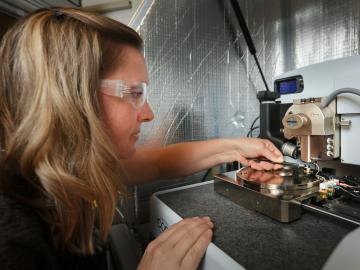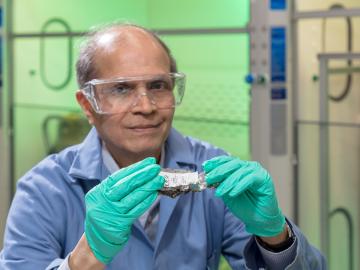
Filter News
Area of Research
- (-) Clean Energy (60)
- (-) Materials (55)
- Advanced Manufacturing (6)
- Biological Systems (1)
- Biology and Environment (4)
- Building Technologies (1)
- Climate and Environmental Systems (2)
- Computational Engineering (1)
- Computer Science (8)
- Fusion Energy (6)
- National Security (5)
- Neutron Science (23)
- Nuclear Science and Technology (11)
- Quantum information Science (3)
- Supercomputing (31)
- Transportation Systems (1)
News Topics
- 3-D Printing/Advanced Manufacturing (14)
- Advanced Reactors (1)
- Artificial Intelligence (2)
- Bioenergy (8)
- Biomedical (1)
- Biotechnology (1)
- Clean Water (5)
- Composites (2)
- Computer Science (7)
- Cybersecurity (1)
- Energy Storage (5)
- Environment (16)
- Fusion (2)
- Grid (2)
- Isotopes (1)
- Machine Learning (1)
- Materials Science (19)
- Mercury (1)
- Microscopy (5)
- Molten Salt (1)
- Nanotechnology (6)
- Neutron Science (6)
- Nuclear Energy (7)
- Physics (2)
- Polymers (2)
- Quantum Science (2)
- Security (1)
- Space Exploration (1)
- Sustainable Energy (8)
- Transportation (11)
Media Contacts

A modern, healthy transportation system is vital to the nation’s economic security and the American standard of living. The U.S. Department of Energy’s Oak Ridge National Laboratory (ORNL) is engaged in a broad portfolio of scientific research for improved mobility

Researchers at Oak Ridge National Laboratory proved that a certain class of ionic liquids, when mixed with commercially available oils, can make gears run more efficiently with less noise and better durability.

A team including Oak Ridge National Laboratory and University of Tennessee researchers demonstrated a novel 3D printing approach called Z-pinning that can increase the material’s strength and toughness by more than three and a half times compared to conventional additive manufacturing processes.

Six new nuclear reactor technologies are set to deploy for commercial use between 2030 and 2040. Called Generation IV nuclear reactors, they will operate with improved performance at dramatically higher temperatures than today’s reactors.

Craig Blue, a program director at the Department of Energy’s Oak Ridge National Laboratory, has been elected a 2019 fellow for SME (formerly known as the Society for Manufacturing Engineers).

When Nina Balke came to the United States on a Feodor Lynen Fellowship for German scholars, her original plan was to complete a year abroad and return home to native opportunities in materials sciences.

Isabelle Snyder calls faults as she sees them, whether it’s modeling operations for the nation’s power grid or officiating at the US Open Tennis Championships.

Electro-Active Technologies, Inc., of Knoxville, Tenn., has exclusively licensed two biorefinery technologies invented and patented by the startup’s co-founders while working at the Department of Energy’s Oak Ridge National Laboratory. The technologies work as a system that converts organic waste into renewable hydrogen gas for use as a biofuel.

Rare earth elements are the “secret sauce” of numerous advanced materials for energy, transportation, defense and communications applications.

IDEMIA Identity & Security USA has licensed an advanced optical array developed at Oak Ridge National Laboratory. The portable technology can be used to help identify individuals in challenging outdoor conditions.


